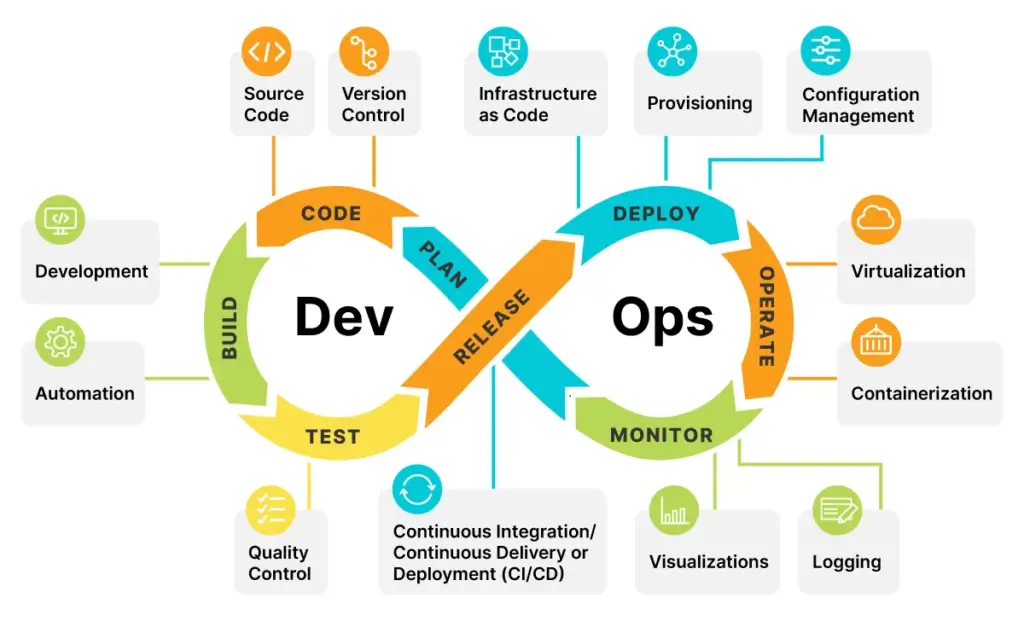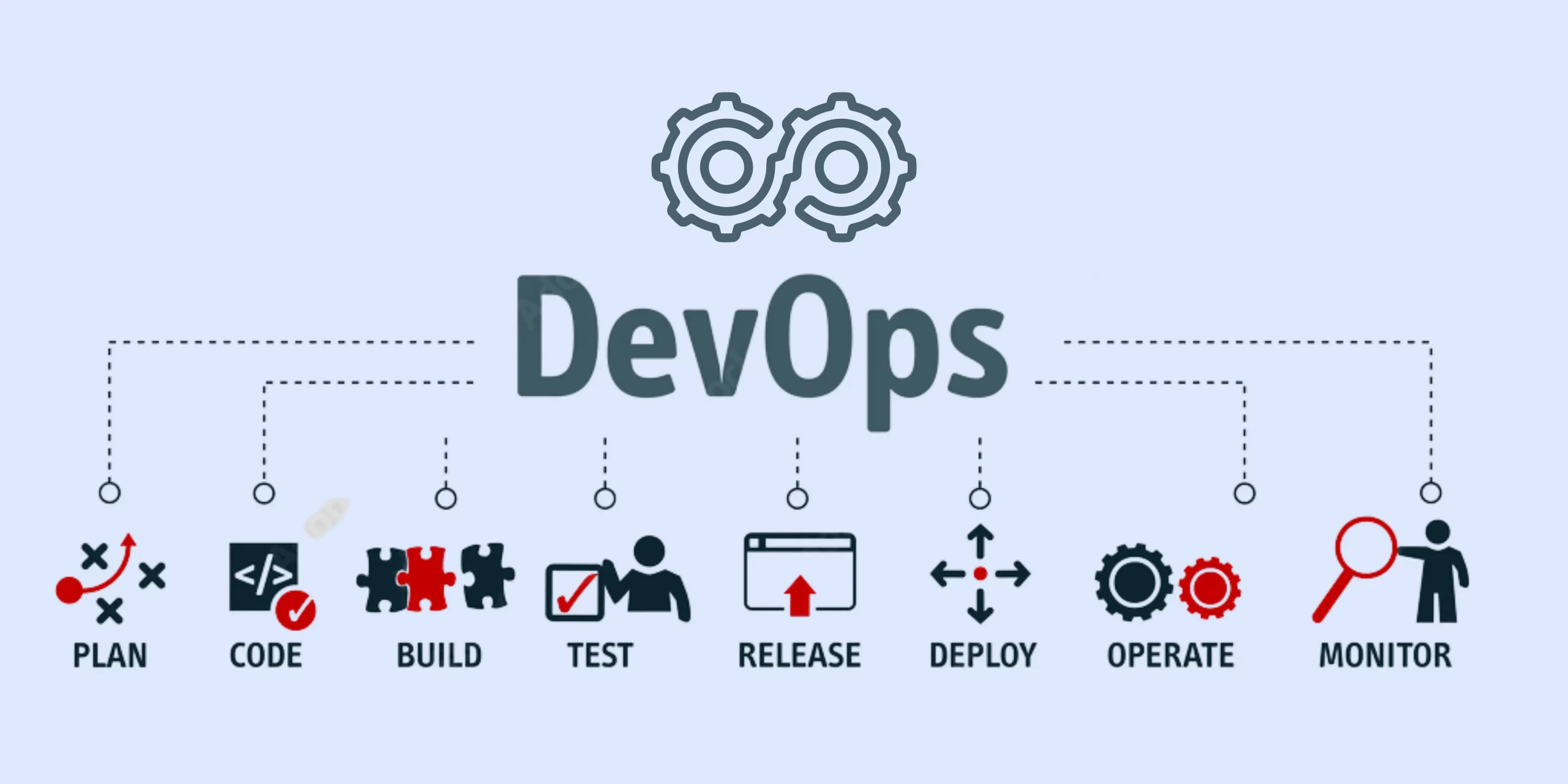In the last few years, the DevOps trend has begun to take shape. It’s a group of IT (Information Technology) leaders who want to see things get better, so they can always and confidently give their clients great software. In 2020, the global DevOps market was worth $6.78 billion. By 2030, it is expected to be worth $57.90 billion, with a compound annual growth rate (CAGR) of 24.2% from 2021 to 2030.
Enterprise DevOps is different from other methods because it brings development and operations together. This makes software development and execution more efficient, timely, and safe. Businesses have an edge when their SDLC (software development lifecycle) is more flexible.
DevOps can coexist with different approaches, including those used for agile software development, IT service management, and project management principles like Lean and Six Sigma. By using the DevOps development process and the principles and tools of DevOps, all the teams can better respond to customer feedback and requests and get the most work done.
Let us learn more about DevOps and why it is a worthwhile investment for businesses in the tech-driven world we live in today.
What is DevOps?

DevOps, a combination of the words “development” and “operations” is a set of practices and tools that help an organization deliver applications and services more quickly than traditional software development methods. Because of this speed, businesses can better serve their customers and do better in the market.
In simple terms, DevOps is about breaking down the walls that have kept development and operations teams separate in the past. Under a DevOps model, the development and operations teams work together throughout the entire life cycle of a software application, from development and testing to deployment and operations.
Our experts can help you to scale your business quickly and get DevOps services.
Evolution of DevOps
In 2007, Belgian government project manager Patrick Debois was helping with data center moves. He had a tough time with the entire process because there was a wall between the developers and the operations team. This made the delivery a lot slower.
Debois was a huge fan of the agile method, which always encourages testing during the development process and lets developers make better products faster. He claimed that the development and operations teams should adopt the same principles when working together.
Here are two of the most important things that came before DevOps:
- Enterprise systems management (ESM)
In the beginning, many of the people who helped define DevOps were system administrators. These operation specialists brought DevOps system monitoring, configuration management, automated provisioning, and the toolchain approach.
- Agile development
To fill in the blanks and rapidly iterate towards a better product, DevOps can be seen as a spinoff of agile software development, which advocates for close cooperation between customers, product managers, developers, and (sometimes) quality assurance.
DevOps team knows how services are delivered, and the application and systems talk are important parts of the client’s value proposition. The product team must address these issues as a top-level item. From this point of view, DevOps is taking the Agile method beyond just the code and applying it to the whole service.
Also Read: How DevOps And Agile Are Influencing Automation in Business?
How do DevOps work?

Moving toward a lean, agile DevOps model makes it possible to release things quickly without sacrificing quality.
What an organization wants to do determines how flexible a DevOps system is. Goals include improving the development frequency, time to make changes, and Average time to get better (MTTR).
There’s no easy answer to the question of how it works. It also needs a complete change in how people think and act inside the company. DevOps requires significant shifts in mindset and culture, including a new way of thinking about trust, an emphasis on top-down execution in large and small doses, and a drive to improve procedures through testing.
Organizations that want to use it must look at the six steps in the system’s life cycle, also known as the “six Cs,” which are the most important parts of how it works.
1. Planning for business all the time
Continuous business planning starts with figuring out what skills an organization has, what goals it wants to reach, and what resources are needed to reach those goals.
Find the right people in the organization who can take the lead in implementing the system. Collaboration is the key to any successful DevOps team, and this team is no different.
2. Development with Others
Implementing Agile methods and breaking down siloed departments are the first steps toward collaborative development. This does not eliminate the idea of centralized planning; it just makes it easier for different teams to work together based on the plan made by one group.
3. Continuous Testing
Testing is the key to making a project faster and more efficient. Unit and functional testing are essential parts of this software development life cycle step. Some organizations have done this in the past to save money, but it is quickly becoming necessary.
Every business has its way of testing, and there is no right or wrong way if it meets the standards of continuous testing.
4. Continuous Release and Deployment
With a continuous CD pipeline, organizations can change and release code when they need to, based on the user’s business goals.
Working together in this area makes it possible for patches to be released and for organizations to quickly meet the needs of their customers, which are constantly growing.
5. Continuous Monitoring
The more complicated a project is, the more likely mistakes will happen. Changes need to be tracked constantly so errors can be fixed whenever and wherever they happen.
This is better than rigid systems, where companies had to rely on customers or hard-to-do manual checks to tell them when something was wrong after a release.
6. Feedback from customers and making changes
The last step in the DevOps process is allowing testers to give feedback immediately. When feedback systems are hard to use, it takes much longer to solve small problems.
Companies can make quick changes when they get immediate customer feedback about a product and its features.
The DevOps model is like a system with many moving parts. Building, deploying, testing, and provisioning automation are the backbone of the framework. In these settings, there needs to be a constant flow of feedback, and everything needs to be recorded.
Also Read: What is The Future of DevOps?
What are the advantages that an enterprise can realize by adopting DevOps?
The Google Cloud Platform & DevOps Research and Assessment (DORA) study for 2021 shows that the main difference between high-performing and low-performing software teams is how quickly they implement the best DevOps techniques. Here are the most critical ways that DevOps helps a business grow.

Faster: Development time is shorter
One of the business benefits of DevOps is that it speeds things up. Because the development and operations teams have their own opinions, it’s hard to understand how valuable an app is. The production and development cycles take too long, which slows down the process.
DevOps encourages collaboration by tearing down walls between the development, operations, and quality assurance teams and pushing them to work together toward a single goal. This gives your organization more value, which lets you give your customers more value. Because people work together, applications and all other related processes can be made faster.
If a company can finish a project twice as fast while keeping the same level of quality, that gives them a competitive edge.
Faster Innovation
Corporate innovation is another clinical benefit of DevOps in the enterprise that is often forgotten. DevOps is the key to using innovative ideas in software development.
With DevOps, you can make software solutions quickly. Your developers will have more time to try out new features or make the ones they already have work better if you can get your products to you faster. Developers can see if these ideas will work by making a proof of concept and then moving forward based on what they find with as little disruption as possible to the current project.
Automation
With enterprise DevOps, a faster deployment process supported by automation can save time. This is because more rapid, smaller deployments that happen more often can save a lot of time. (That’s time that could be better used to solve other business problems or encourage innovative ideas.)
What do you think you should automate? Start by putting your attention on the regular parts of your releases. Most of the time, certain parts of testing and writing requirements can be done automatically. But you need to know why you are automating and how much time you think you will save. Although automation can be convenient, not all applications merit the development time and resources.
Minimum costs to make something
The DevOps method is based on automating all operations in the development lifecycle. Tools like Continuous Integration (CI), Infrastructure as a Code (IaC), and Continuous Delivery (CD) that are based on DevOps principles focus on making sure that tasks are done the same way and that the infrastructure is safe. It makes automation 100% reliable and cuts the amount of time and effort spent on repetitive and routine work by a large amount.
DevOps helps your departments save money on management and production costs by bringing maintenance and new upgrades under a larger umbrella. This makes it easier for everyone to work together.
The problem of inefficient use of resources is solved by moving to the cloud. Top public cloud providers like Amazon Web Services, Google Cloud Platform, and Microsoft Azure use auto-scaling and load balancing to ensure that resources are used efficiently.
Faster ROI (Return on Investment)
Businesses can get their IT investments back and start making pure cash by putting out new updates faster and fixing bugs quickly. 2020 research shows that DevOps collaboration saves 22% of the time that would have been spent on rework and unplanned tasks.
Also, when it comes to production, a higher quality product cuts the time spent on security issues by 50%. Your apps will work better and bring in more money.
If your company has the five pillars listed below, it can increase its return on investment (ROI) while lowering its total cost of ownership and operational costs.
- Operational excellence is the best way to help the development lifecycle and effectively run programs.
- Hardened security is a way to protect data and systems better and includes the best ways to use cloud services to strengthen security.
- The infrastructure is good when each part works well and does what it is supposed to, as defined by the reliability pillar.
- Performance efficiency means using IT resources in the best way possible.
- Cost optimization refers to real-world ways to run workloads in a way that is both efficient and good for the budget. This pillar helps people figure out how to offer more benefits for less money.
Customer satisfaction has improved
One of the best things about DevOps for business is that it helps improve customer satisfaction. Customers hate having to wait; the longer they wait, the worse it is for business. As was already said, DevOps speeds up the delivery of software, which directly and positively affects customer satisfaction. Also, because enterprise DevOps makes your workflow more efficient in many ways, you’ll be able to sell your products for less than a competitor who does not use DevOps.
Service Delivery You Can Trust
One of the best things about DevOps is that it is reliable, and a key indicator of value for clients. Getting things to clients on time is key to making them happy. Using DevOps methods, businesses can break down large projects into smaller pieces that each have their own set of skills.
DevOps can help meet the needs of the many parts of a larger project at the start and the end. DevOps makes it possible to make changes at any time during the process. Because of this, businesses can use the benefits of DevOps to make service delivery better and more reliable.
High Productivity through Working together
High productivity speeds up production and makes it less likely that mistakes will happen. Because silos are broken down, and collaboration is encouraged, team members can talk to each other better and focus more on their own areas of expertise. So, putting DevOps methods into place has led to a rise in the productivity and efficiency of a company’s employees. Also, when there is a problem, processes do not have to wait for certain teams. When everyone works together, all systems and steps become clearer.
Also Read: Top 5 Reasons DevOps And Security Need To Work Together
Conclusion
Businesses no longer want to know what the benefits of DevOps are. Instead, they are busy making plans to become more flexible. Service availability can be enhanced through collaboration with a knowledgeable DevOps partner such as JumpGrowth.
JumpGrowth can help you with every step of your DevOps adoption and give you good advice. Get in touch with us right away to find out what they can do to boost your business’s profitability.
Our experts can help you to scale your business quickly and get DevOps services.
FAQs
Q. Why is DevOps important to a company?
A. DevOps is important to a company because it helps to improve the overall workflow and process of a company. By bringing together a variety of different departments and working together to improve the overall process, DevOps helps to streamline operations and make it easier for employees to work together. Additionally, DevOps helps companies to better manage and monitor their systems, making it easier to identify and fix problems.
Q. What is DevOps in scaled agile?
A. DevOps is a software development framework that integrates practices from the software engineering and operations communities to create an integrated process for developing and deploying software. In scaled agile, DevOps is used to enable continuous delivery and continuous integration of code into the software development system.
Q. Why is DevOps so popular?
A. There are a number of reasons why DevOps is popular. First, it allows companies to improve the overall reliability and quality of their software products. Second, it can reduce development time and costs. And finally, it can help companies improve communication and collaboration between different departments within the company.
Q. What is special about DevOps?
A. One of the key distinguishing characteristics of DevOps is its focus on collaboration and communication across all stakeholders in the software delivery process. This includes developers, operations staff, and quality assurance professionals. By working together as a team, everyone can identify and resolve issues quickly and efficiently, leading to a more reliable and successful product.
Q. What benefit can DevOps bring to an organization?
A. DevOps can improve an organization’s agility, scalability, and reliability. Additionally, it can help to streamline the management of software development and IT operations.


























